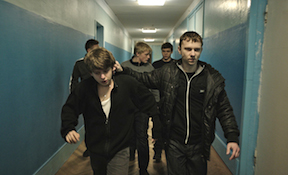Communication Breakdown - The Tribe
 Sunday, July 19, 2015 at 08:06PM
Sunday, July 19, 2015 at 08:06PM THE TRIBE - Miroslav Slaboshptskiy
A young innocent travels to the big city. The rushing traffic, construction sites and human babble are deafening. But not to the innocent; he’s deaf. He finds his way to an institution, arriving in the midst of an elaborate ceremony of government oversight and adult supervision. Once inside, the innocent finds neither. The other boys humiliate him, take the food off his plate, steal everything he owns, beat him, kick him, shove him from room to room and leave him to sleep in the hall.
 In The Tribe’s circumscribed environment – a government-run warehouse for deaf teenagers masquerading as a boarding school – brutality maintains the tribal hierarchy. Those at the top waste no time inflicting the hierarchy on the newcomer. He wastes no time accepting his place. Before long, he spends his nights pimping high school girls to truck drivers. He thinks falling in love might give the hierarchy less power over him or provide him a reason to live. It does neither.
In The Tribe’s circumscribed environment – a government-run warehouse for deaf teenagers masquerading as a boarding school – brutality maintains the tribal hierarchy. Those at the top waste no time inflicting the hierarchy on the newcomer. He wastes no time accepting his place. Before long, he spends his nights pimping high school girls to truck drivers. He thinks falling in love might give the hierarchy less power over him or provide him a reason to live. It does neither.
The Tribe is a merciless amalgam of Lord of the Flies, Theodore Dreiser, Sinclair Lewis and Tod Browning’s Freaks. Left to their own devices, disenfranchised, outcast adolescents – metaphors for the adult society and economy crumbling around them – devolve to an animal state: They eat, they fight, they get fucked up, they fuck. None of them – save the newcomer – appear to reflect. They’re too busy surviving.
First-time Ukrainian director Miroslav Slaboshpytskiy explains nothing. If you understand signing, you can tap into what appears to be a world of expressive thought and emotion. If, like me, you do not, the story emerges from the kids’ physicality. That’s their only mode of expression and they are profoundly expressive. Perhaps the kids evince neurosis; maybe they act in opposition to what they think and feel. Non-signing viewers can only interpret their actions. Look away for an instant and a crucial, tiny narrative moment slips by: A glance, a blow, a nod, a touch that remakes the world.
Their struggles prove hypnotically compelling. The tribe at first seems otherworldly. Slaboshpytskiy gradually exposes their humanity or how it's been destroyed. It feels like the director wants to turn the tables; he wants the hearing to experience how the deaf perceive them – as ciphers.
The Tribes’ style springs from the explosion of astonishing Romanian films, Police, Adjective and 4 Months 3 Weeks and 2 Days, foremost. Like Corneliu Porumboiu and Cristian Mungiu respectively, Slaboshpytskiy had no money. Like his Romanian forbears, he couldn’t afford cranes, complex lighting setups or special effects. Slaboshpytskiy presents a simple, rigorous cinematic language of revelatory, understated sophistication. He tells the story in a succession of long uninterrupted medium shots, vesting in narrative, character, grim locations, harsh natural lighting and guttural diegetic sound.
Slaboshpytskiy's no social realist, like Dreiser. He’s a hyper-realist, a natural cineaste, and depicts his world unflinchingly. With deceptively simple frames and metronomic pacing, he sets the visual, moral and dramatic tone at the outset and never deviates from it. His dedication to pace and tone sustains a compelling claustrophobia.
The world surrounding the story looms present by the absence of any direct reference to it. Even the brief moments of sentiment occur in a vortex of moral and financial bankruptcy. When state authority impinges on the kids’ lives, it proves corrupt and vampiric. In one of those easily missed realist moments, the pimped girls rejoice at their new passports and visas for Italy. They don’t realize they’re being sold into slavery. The adults responsible aren’t about to explain it to them.
The critical response has been passionate and varied. Some, like me, think The Tribe is the best film of the year. Others regard the unrelenting violence and transgression as exploitative and self-indulgent. Anyone who finds the viciousness excessive or unrealistic must have never been bullied in high school. If they had, they’d regard the mayhem, and especially the vengeance for that mayhem, as more documentary than dramatic. The director’s commitment to the horror provides The Tribe’s dramatic spine. Turning away at the worst moments would be a moral failure.
And when The Tribe transgresses, it does not mess around. It features the single most harrowing and unbearable scene I’ve ever seen. It’s worse than anything in Michael Haneke’s Funny Games, and that’s really saying something. As it played, and as it became increasingly clear Slaboshpitsky would not cut away until the moment was fully lived out, I found myself thinking: “I can’t believe I’m actually seeing a depiction of (x).” The scene starts badly and turns into exactly what you think it wouldn’t dare.
The other moment that generates simultaneous fascination and distancing features two naked, deaf teenagers 69’ing on the dank floor of a deserted boiler room. And, boy, do they 69. Like the unwatchable scene, this one goes on a while, in a static medium wide shot. Though transcendent for the participants, it plays as deliberately anti-erotic. It’s explicit, but not porny. In Slaboshpitsky’s universe, two naked, deaf teenagers 69’ing on the dank floor of a deserted boiler room in a state-run hellhole can only be one thing: A love scene.

